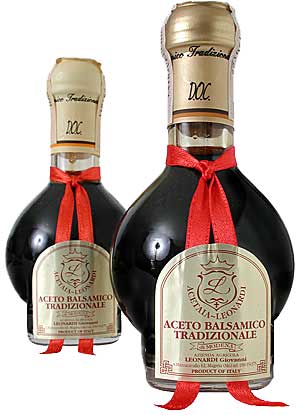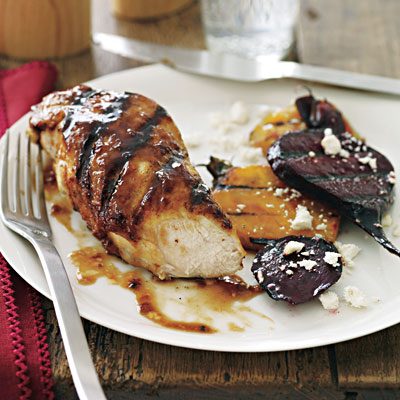
Traditionally, balsamic vinegar is made from boiled down grape juice. It gets its flavor as it ages in barrels made of various woods: cherry, chestnut, acacia, oak, ash, juniper and mulberry. Over several years, water evaporates so they keep pouring the vinegar into smaller and smaller casks. The finished product ends up tasting concentrated and raisin-y with woody, sometimes resinous, flavors. I have very generous friends who give me some fancy bottle of balsamic vinegar every year for Christmas. Not to sound ungrateful but I hate the stuff.
 Does this look appetizing?
Does this look appetizing?
I think it’s so popular because it’s sweet and instantly recognizable. But it’s also incredibly overpowering. A sage-dusted apricot-balsamic glazed chicken breast is just going to taste like chicken dipped in balsamic vinegar. A microgreen salad with an herb raspberry-balsamic dressing is just going to taste like lettuce soaked in balsamic. It’s kind of like Adam Sandler – his movies are dominated by his semi-amusing schtick and there’s not a lot of variation from film to film. But you know what you’re getting so you’re not risking much by buying a ticket. Similarly, there’s not much mystery about what your balsamic dressing’s going to taste like. Me, I like my salads to taste like something more than just cloying vinegar.
 note that it says "gourmet"
note that it says "gourmet"
So my little trick is to add a tiny splash of seasoned rice vinegar in most of my salad dressings. Seasoned rice vinegar contains added sugar and salt and it has a neutral flavor with mild acidity. So it rounds out the sharpness of a red wine vinegar or lemon juice without adding the sledgehammer flavors of balsamic vinegar. It heightens whatever flavors you have in the salad. People could actually taste the nectarines I put in the salad. Just don’t add too much SRV (if Rachel Ray gets EVO, I'm taking SRV). A little sweetness goes a long way.
 Traditionally, balsamic vinegar is made from boiled down grape juice. It gets its flavor as it ages in barrels made of various woods: cherry, chestnut, acacia, oak, ash, juniper and mulberry. Over several years, water evaporates so they keep pouring the vinegar into smaller and smaller casks. The finished product ends up tasting concentrated and raisin-y with woody, sometimes resinous, flavors. I have very generous friends who give me some fancy bottle of balsamic vinegar every year for Christmas. Not to sound ungrateful but I hate the stuff.
Traditionally, balsamic vinegar is made from boiled down grape juice. It gets its flavor as it ages in barrels made of various woods: cherry, chestnut, acacia, oak, ash, juniper and mulberry. Over several years, water evaporates so they keep pouring the vinegar into smaller and smaller casks. The finished product ends up tasting concentrated and raisin-y with woody, sometimes resinous, flavors. I have very generous friends who give me some fancy bottle of balsamic vinegar every year for Christmas. Not to sound ungrateful but I hate the stuff.
 Does this look appetizing?
I think it’s so popular because it’s sweet and instantly recognizable. But it’s also incredibly overpowering. A sage-dusted apricot-balsamic glazed chicken breast is just going to taste like chicken dipped in balsamic vinegar. A microgreen salad with an herb raspberry-balsamic dressing is just going to taste like lettuce soaked in balsamic. It’s kind of like Adam Sandler – his movies are dominated by his semi-amusing schtick and there’s not a lot of variation from film to film. But you know what you’re getting so you’re not risking much by buying a ticket. Similarly, there’s not much mystery about what your balsamic dressing’s going to taste like. Me, I like my salads to taste like something more than just cloying vinegar.
Does this look appetizing?
I think it’s so popular because it’s sweet and instantly recognizable. But it’s also incredibly overpowering. A sage-dusted apricot-balsamic glazed chicken breast is just going to taste like chicken dipped in balsamic vinegar. A microgreen salad with an herb raspberry-balsamic dressing is just going to taste like lettuce soaked in balsamic. It’s kind of like Adam Sandler – his movies are dominated by his semi-amusing schtick and there’s not a lot of variation from film to film. But you know what you’re getting so you’re not risking much by buying a ticket. Similarly, there’s not much mystery about what your balsamic dressing’s going to taste like. Me, I like my salads to taste like something more than just cloying vinegar.
 note that it says "gourmet"
So my little trick is to add a tiny splash of seasoned rice vinegar in most of my salad dressings. Seasoned rice vinegar contains added sugar and salt and it has a neutral flavor with mild acidity. So it rounds out the sharpness of a red wine vinegar or lemon juice without adding the sledgehammer flavors of balsamic vinegar. It heightens whatever flavors you have in the salad. People could actually taste the nectarines I put in the salad. Just don’t add too much SRV (if Rachel Ray gets EVO, I'm taking SRV). A little sweetness goes a long way.
note that it says "gourmet"
So my little trick is to add a tiny splash of seasoned rice vinegar in most of my salad dressings. Seasoned rice vinegar contains added sugar and salt and it has a neutral flavor with mild acidity. So it rounds out the sharpness of a red wine vinegar or lemon juice without adding the sledgehammer flavors of balsamic vinegar. It heightens whatever flavors you have in the salad. People could actually taste the nectarines I put in the salad. Just don’t add too much SRV (if Rachel Ray gets EVO, I'm taking SRV). A little sweetness goes a long way.
No comments:
Post a Comment